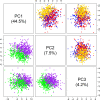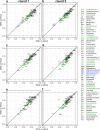Low-cost sample preservation methods for high-throughput processing of rumen microbiomes
- PMID: 35668514
- PMCID: PMC9171989
- DOI: 10.1186/s42523-022-00190-z
Low-cost sample preservation methods for high-throughput processing of rumen microbiomes
Abstract
Background: The use of rumen microbial community (RMC) profiles to predict methane emissions has driven interest in ruminal DNA preservation and extraction protocols that can be processed cheaply while also maintaining or improving DNA quality for RMC profiling. Our standard approach for preserving rumen samples, as defined in the Global Rumen Census (GRC), requires time-consuming pre-processing steps of freeze drying and grinding prior to international transportation and DNA extraction. This impedes researchers unable to access sufficient funding or infrastructure. To circumvent these pre-processing steps, we investigated three methods of preserving rumen samples for subsequent DNA extraction, based on existing lysis buffers Tris-NaCl-EDTA-SDS (TNx2) and guanidine hydrochloride (GHx2), or 100% ethanol.
Results: Rumen samples were collected via stomach intubation from 151 sheep at two time-points 2 weeks apart. Each sample was separated into four subsamples and preserved using the three preservation methods and the GRC method (n = 4 × 302). DNA was extracted and sequenced using Restriction Enzyme-Reduced Representation Sequencing to generate RMC profiles. Differences in DNA yield, quality and integrity, and sequencing metrics were observed across the methods (p < 0.0001). Ethanol exhibited poorer quality DNA (A260/A230 < 2) and more failed samples compared to the other methods. Samples preserved using the GRC method had smaller relative abundances in gram-negative genera Anaerovibrio, Bacteroides, Prevotella, Selenomonas, and Succiniclasticum, but larger relative abundances in the majority of 56 additional genera compared to TNx2 and GHx2. However, log10 relative abundances across all genera and time-points for TNx2 and GHx2 were on average consistent (R2 > 0.99) but slightly more variable compared to the GRC method. Relative abundances were moderately to highly correlated (0.68 ± 0.13) between methods for samples collected within a time-point, which was greater than the average correlation (0.17 ± 0.11) between time-points within a preservation method.
Conclusions: The two modified lysis buffers solutions (TNx2 and GHx2) proposed in this study were shown to be viable alternatives to the GRC method for RMC profiling in sheep. Use of these preservative solutions reduces cost and improves throughput associated with processing and sequencing ruminal samples. This development could significantly advance implementation of RMC profiles as a tool for breeding ruminant livestock.
Keywords: Genotyping-by-sequencing; PstI; RE-RRS; Rumen microbial profiles; Rumen microbiology; Superorganism.
© 2022. The Author(s).
Conflict of interest statement
The authors declare that they have no competing interests.
Figures







Similar articles
-
Rumen metagenome profiles are heritable and rank the New Zealand national sheep flock for enteric methane emissions.Genet Sel Evol. 2025 May 27;57(1):25. doi: 10.1186/s12711-025-00973-3. Genet Sel Evol. 2025. PMID: 40426027 Free PMC article.
-
A restriction enzyme reduced representation sequencing approach for low-cost, high-throughput metagenome profiling.PLoS One. 2020 Apr 3;15(4):e0219882. doi: 10.1371/journal.pone.0219882. eCollection 2020. PLoS One. 2020. PMID: 32243481 Free PMC article.
-
Large-scale analysis of sheep rumen metagenome profiles captured by reduced representation sequencing reveals individual profiles are influenced by the environment and genetics of the host.BMC Genomics. 2023 Sep 18;24(1):551. doi: 10.1186/s12864-023-09660-3. BMC Genomics. 2023. PMID: 37723422 Free PMC article.
-
Application of meta-omics techniques to understand greenhouse gas emissions originating from ruminal metabolism.Genet Sel Evol. 2017 Jan 16;49(1):9. doi: 10.1186/s12711-017-0285-6. Genet Sel Evol. 2017. PMID: 28093073 Free PMC article. Review.
-
Genome sequencing of rumen bacteria and archaea and its application to methane mitigation strategies.Animal. 2013 Jun;7 Suppl 2:235-43. doi: 10.1017/S1751731113000700. Animal. 2013. PMID: 23739466 Review.
Cited by
-
Rumen metagenome profiles are heritable and rank the New Zealand national sheep flock for enteric methane emissions.Genet Sel Evol. 2025 May 27;57(1):25. doi: 10.1186/s12711-025-00973-3. Genet Sel Evol. 2025. PMID: 40426027 Free PMC article.
-
A workflow for the detection of antibiotic residues, measurement of water chemistry and preservation of hospital sink drain samples for metagenomic sequencing.J Hosp Infect. 2024 Feb;144:128-136. doi: 10.1016/j.jhin.2023.11.021. Epub 2023 Dec 23. J Hosp Infect. 2024. PMID: 38145816 Free PMC article.
-
Comparison of DNA quantity and quality from fecal samples of mammals transported in ethanol or lysis buffer.One Health. 2024 Apr 13;18:100731. doi: 10.1016/j.onehlt.2024.100731. eCollection 2024 Jun. One Health. 2024. PMID: 38655016 Free PMC article.
References
-
- Huws SA, Creevey CJ, Oyama LB, Mizrahi I, Denman SE, Popova M, Muñoz-Tamayo R, Forano E, Waters SM, Hess M. Addressing global ruminant agricultural challenges through understanding the rumen microbiome: past, present, and future. Front Microbiol. 2018;9:2161. doi: 10.3389/fmicb.2018.02161. - DOI - PMC - PubMed
Grants and funding
- PhD scholarship/Brazilian Federal Agency for Support and Evaluation of Graduate Education (CAPES)
- SOW14-AGR-GPLER-SP5-SR/Global Research Alliance
- SOW14-AGR-GPLER-SP5-SR/Global Research Alliance
- C10X1807/Ministry of Business, Innovation and Employment
- C10X1807/Ministry of Business, Innovation and Employment
LinkOut - more resources
Full Text Sources
